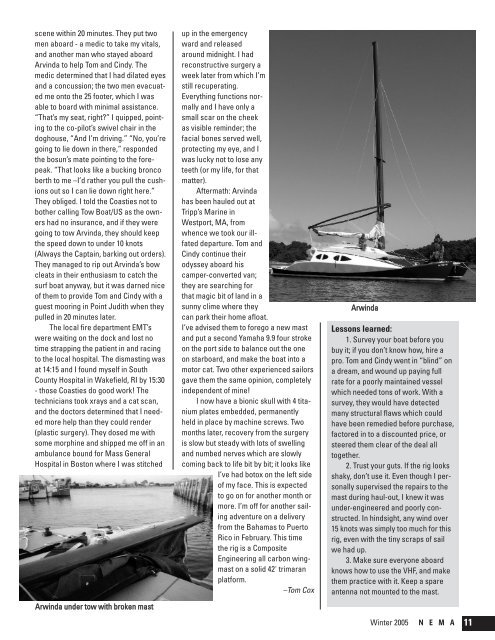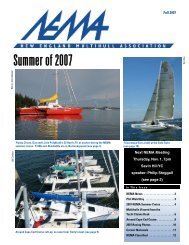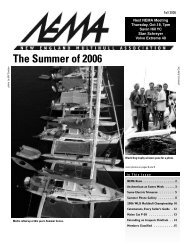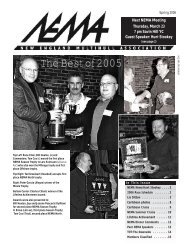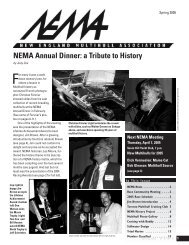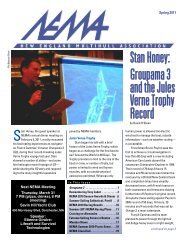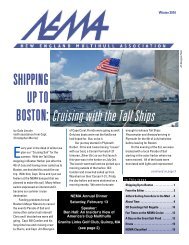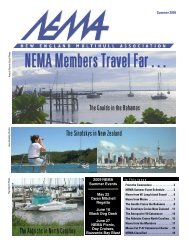Winter 2005 - New England Multihull Association
Winter 2005 - New England Multihull Association
Winter 2005 - New England Multihull Association
Create successful ePaper yourself
Turn your PDF publications into a flip-book with our unique Google optimized e-Paper software.
scene within 20 minutes. They put two<br />
men aboard - a medic to take my vitals,<br />
and another man who stayed aboard<br />
Arvinda to help Tom and Cindy. The<br />
medic determined that I had dilated eyes<br />
and a concussion; the two men evacuated<br />
me onto the 25 footer, which I was<br />
able to board with minimal assistance.<br />
“That’s my seat, right?” I quipped, pointing<br />
to the co-pilot’s swivel chair in the<br />
doghouse, “And I’m driving.” “No, you’re<br />
going to lie down in there,” responded<br />
the bosun’s mate pointing to the forepeak.<br />
“That looks like a bucking bronco<br />
berth to me –I’d rather you pull the cushions<br />
out so I can lie down right here.”<br />
They obliged. I told the Coasties not to<br />
bother calling Tow Boat/US as the owners<br />
had no insurance, and if they were<br />
going to tow Arvinda, they should keep<br />
the speed down to under 10 knots<br />
(Always the Captain, barking out orders).<br />
They managed to rip out Arvinda’s bow<br />
cleats in their enthusiasm to catch the<br />
surf boat anyway, but it was darned nice<br />
of them to provide Tom and Cindy with a<br />
guest mooring in Point Judith when they<br />
pulled in 20 minutes later.<br />
The local fire department EMT’s<br />
were waiting on the dock and lost no<br />
time strapping the patient in and racing<br />
to the local hospital. The dismasting was<br />
at 14:15 and I found myself in South<br />
County Hospital in Wakefield, RI by 15:30<br />
- those Coasties do good work! The<br />
technicians took xrays and a cat scan,<br />
and the doctors determined that I needed<br />
more help than they could render<br />
(plastic surgery). They dosed me with<br />
some morphine and shipped me off in an<br />
ambulance bound for Mass General<br />
Hospital in Boston where I was stitched<br />
Arwinda under tow with broken mast<br />
up in the emergency<br />
ward and released<br />
around midnight. I had<br />
reconstructive surgery a<br />
week later from which I’m<br />
still recuperating.<br />
Everything functions normally<br />
and I have only a<br />
small scar on the cheek<br />
as visible reminder; the<br />
facial bones served well,<br />
protecting my eye, and I<br />
was lucky not to lose any<br />
teeth (or my life, for that<br />
matter).<br />
Aftermath: Arvinda<br />
has been hauled out at<br />
Tripp’s Marine in<br />
Westport, MA, from<br />
whence we took our illfated<br />
departure. Tom and<br />
Cindy continue their<br />
odyssey aboard his<br />
camper-converted van;<br />
they are searching for<br />
that magic bit of land in a<br />
sunny clime where they<br />
can park their home afloat.<br />
I’ve advised them to forego a new mast<br />
and put a second Yamaha 9.9 four stroke<br />
on the port side to balance out the one<br />
on starboard, and make the boat into a<br />
motor cat. Two other experienced sailors<br />
gave them the same opinion, completely<br />
independent of mine!<br />
I now have a bionic skull with 4 titanium<br />
plates embedded, permanently<br />
held in place by machine screws. Two<br />
months later, recovery from the surgery<br />
is slow but steady with lots of swelling<br />
and numbed nerves which are slowly<br />
coming back to life bit by bit; it looks like<br />
I’ve had botox on the left side<br />
of my face. This is expected<br />
to go on for another month or<br />
more. I’m off for another sailing<br />
adventure on a delivery<br />
from the Bahamas to Puerto<br />
Rico in February. This time<br />
the rig is a Composite<br />
Engineering all carbon wingmast<br />
on a solid 42' trimaran<br />
platform.<br />
–Tom Cox<br />
Arwinda<br />
Lessons learned:<br />
1. Survey your boat before you<br />
buy it; if you don’t know how, hire a<br />
pro. Tom and Cindy went in “blind” on<br />
a dream, and wound up paying full<br />
rate for a poorly maintained vessel<br />
which needed tons of work. With a<br />
survey, they would have detected<br />
many structural flaws which could<br />
have been remedied before purchase,<br />
factored in to a discounted price, or<br />
steered them clear of the deal all<br />
together.<br />
2. Trust your guts. If the rig looks<br />
shaky, don’t use it. Even though I personally<br />
supervised the repairs to the<br />
mast during haul-out, I knew it was<br />
under-engineered and poorly constructed.<br />
In hindsight, any wind over<br />
15 knots was simply too much for this<br />
rig, even with the tiny scraps of sail<br />
we had up.<br />
3. Make sure everyone aboard<br />
knows how to use the VHF, and make<br />
them practice with it. Keep a spare<br />
antenna not mounted to the mast.<br />
<strong>Winter</strong> <strong>2005</strong> N E M A<br />
11


